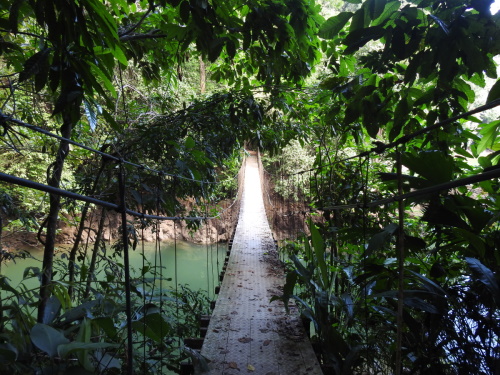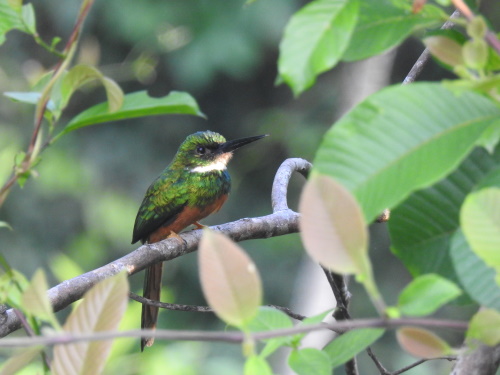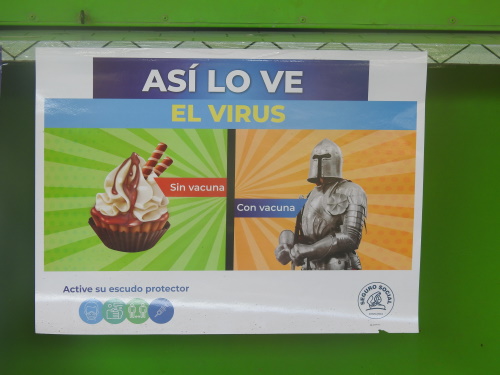Blog Countries
Tips for travelling to Costa Rica
In March 2021 I spent 2 weeks in Costa Rica, my first visit to this country. It had never been that high on my wish list – too touristy and no specific highlights that appealed to me. But it’s quite an ideal destination during Covid times: a real outdoor destination with good healthcare and few limitations. I easily covered 3 of its WHS, its only TWHS and several additional parks by rental car. Find below my Top Tips for Travelling to Costa Rica as a World Heritage Traveller.

1. It's so easy
Travelling in Costa Rica is like doing a jigsaw puzzle with only 100 pieces. The travel complexity factor is very low: everything runs smoothly, a lot of English is spoken, it is remarkably clean, you can drink the tap water, you can pay in USD or colones which both can be withdrawn from ATM’s. Many accommodations are owned by foreigners who cater to North American and/or Western European tastes. All this makes Costa Rica an ideal destination for travellers who venture outside of their own continent for the first time or those travelling with families.
2. Go meet the birds and the butterflies
The natural green surroundings almost everywhere are clearly Costa Rica’s main strength. Even when you’re not a birder, signing up for a bird walk will be rewarding here. The country also has beautiful large butterflies. Just enjoy the countryside in slow motion by hiking or spending the night in a rural area. The zones right outside of the (often pricey and overly manicured) national parks can be just as rewarding.
3. Create your own balanced itinerary
There is a really well-trodden tourist trail around the country, but with a focus on WHS and also including a couple of cultural sights in addition to the best national parks you will get more out of your trip. The capital San José is worth a day for reasons I already described here. The FTWHS of Guayabo archaeological site certainly warrants a visit. And I did enjoy Marino Ballena national park near Uvita as the best non-WHS natural site - you can do great long beach walks here. Esteban has provided me with a wealth of trip ideas, I will share some of them on the Forum for future use.
4. Don't skip the Osa Peninsula
The Osa Peninsula was the highlight of Costa Rica for me. This included the day trip to the Sirena station of Corcovado NP for example (overnighting is not possible at the moment). But I also enjoyed the Drake Bay Trail, a lovely coastal hike that you can do on your own for as long as you like (the full trail is 20km long, one way). And I did a private guided birding tour in the outskirts of Drake Bay in patches of primary forest, which resulted in views of three species of manakin and other colourful birds.
5. Rental car or public transport?
Due to being able to stay in my own little Covid bubble, I travelled around alone in a rental car. I had a Hyundai Creta SUV - no 4WD but a 2WD. The high clearance came in handy about 2 or 3 times, for those final 5km towards a destination. I found car rental pretty expensive, usually I take the smallest and cheapest car available but that’s not an option when you need a SUV. The driving itself was easy as long as you’re not in a hurry. In non-Covid times I’d certainly would have done this trip by public transport. Buses will get you to most places, albeit in a bit more time. The twice daily Drake Bay – Sierpe boat service for example was awaited by minibuses set for Palmar Norte.
The (T)WHS of Costa Rica are seriously underreviewed at this website. Please write down some of your memories no matter from how long ago in a review.
Els - 25 April 2021
Comments
Esteban Cervantes Jiménez (WHS) 26 April 2021
Well, it's great to have helped you have the best experience possible, Els. I always really find interesting to see what people from other countries think of Costa Rica. Normally, the experience of tourists (and many Costa Ricans, who know mainly shopping malls, all-included hotels and always the same beaches) is very poor and superficial, getting to the extreme of thinking that there aren’t cultural destinations. As an avid hiker and someone who fully knows 333/488 districts of the country (and who knows in part another 85), I guess I have some criteria on that. Then, my main purpose was to provide you with the richest and most varied experience possible, on a limited schedule.
Regarding what you say of rural areas, I agree. Not only environmental policies have resulted in private areas sharing many features with neighboring protected areas, but also areas like Zona de los Santos, northern Cartago, Turrialba, El Guarco, Occidente, Puriscal-Mora-Acosta municipalities, etc., are favorite destinations of me and rewarding in many senses. On a normal hike I usually get to experience great landscapes, forested areas, some wildlife, rivers to swim at, agricultural lands, towns with maybe a heritage church, school or house, people, “comida típica” and a rich cultural experience.
Therefore, my advices for people visiting the country would be:
a) It is a real pity to see tourists always circling between Manuel Antonio, Monteverde, La Fortuna, Jacó, Tamarindo, Puerto Viejo-Cahuita and maybe the Poás and Irazú volcanoes NPs. Even when doing that beaten track, some variations may be possible: for example, Carara National Park near Jacó is a great chance to see a transition from a dry-tropical to a wet-tropical life zone and Orotina -nearby- has interesting railroad history, Cerro Chato near the Arenal volcano is a demanding hike to an exuberant cloud forest and a pristine volcanic lagoon, Playa Grande near Tamarindo is near the entrance point to Las Baulas National Park, etc.
b) Venture outside the beaten path and try some rural tourism too: it may not only benefit a community and create productive chains, but would additionally be the best mean to get insight of the country's real and regionally-varied nuances.
c) I would also consider visiting an indigenous reserve: they provide a really different culture experience: I have the feeling that festivities like “El Baile de los Diablitos” from the Boruca people, el “Baile de la Yegüita” from the Chorotegas in Nicoya, or “La Jala de la Piedra” from the Bribri people will sometime be inscribed in the Intangible Heritage List. Many of these communities are in the poorest parts of the country, so visiting a Ngöbe, Maleku, Teribe, Huetar or Cabécar town would also be great, if you approach their communities and traditions with respect.
d) As stated before, there isn’t a homogenous “Costa Rican” culture, landscape or feel, they are as diverse as our microclimates. To incorporate different regions in a same trip is great to see variety. Even between regions that were populated through the outwards migratory movement of “white” or mestizo people from the Central Valley (1840s-1910s), there are differences. Additionally, different migratory movements after independence (from Europeans in the 19th and early 20th centuries, Jews, Afro-Antilleans, Chinese, Lebanese, people escaping from Latin American dictatorships in the 1970s and 1980s and back again now, Colombians, Nicaraguans, Panamanians, Venezuelans, etc.) have enriched the culture of many areas.
e) Regarding cities/towns, I would not skip them either. As Els says, San José (still) has things that are worth a visit: just this 44 km2 municipality has 90 heritage buildings and sites and many which potentially be declared so. Though all cities have suffered decades of loss of their heritage (as Els describes in her San José review), some still have public spaces, buildings, places that could be rewarding: Heredia, Cartago, Santa Domingo (recommended), Atenas, Alajuela, Palmares, Naranjo, San Ramón, Grecia, Barva (partly lacking authencity, but still interesting besides its central park), Ciudad Colón, San Joaquín de Flores, etc., have (in my view) something interesting. Outside the Central Valley, Puntarenas is a great experience of a coastal city, Esparza and San Mateo preserve many of their Victorian buildings, Liberia and to some extent other Guanacastecan cities an towns (Nicoya, Santa Cruz, Bagaces, towns like Quebrada Honda, Bolsón and Santa Bárbara de Diriá) show a really different cultural background than the Central Valley (and I suspect that part of Liberia may be a future TL Site), Limón is dilapidated, unsafe and poor as can be, but has this rich past, Victorian architecture and Afro-Caribbean feel really got me during a visit I made last January (and they’re working towards using that as an engine for urban renewal and social fabric restoration), “plantation” towns like Golfito, Quepos, and Palmar Sur keep some of their 1930s-1940s heritage, etc.
f) Regarding food, I think there is also this prevalent idea of Costa Ricans only eating rice, beans and “Casados” and it's really not like that. I don't want to be super extensive on this, but the country has different regional variations, from the very established culinary tradition of Guanacaste -with a distinctive Mesoamerican tradition, and corn-oriented dishes- to the Southern-Caribbean food, the great seafood and desserts at Puntarenas, to the important Chinese community that flourished in the country and is practically everywhere, to the Costa Rican regional varieties of coffee (with Tarrazú, and Turrialba being my favorites). Just referring to the Central Valley, I can mention the variety of "picadillos", soups (like “Olla de Carne”, or “Sopa Negra”), rice dishes, corn dishes, seafood-based Holy Week dishes, sweets (like "cajetas", "guayabitas", "dulces" or “mieles” of different fruits and vegetables, "Tres Leches" and other pies), natural fruit drinks, “Chifrijo” and other “bocas”, and others. For your reference, I share with you the link to these traditional cooking books that the Heritage Center has developed, specialized each of them on a specific region: https://mcj.go.cr/sala-de-prensa/noticias/descargue-los-recetarios-del-centro-de-patrimonio-y-redescubra-la-cocina
Lastly, needless to say, if you require some advice on places to visit, please consider my e-mail address: vant83@gmail.com. I will try -with my sometimes-limited time- to provide detailed orientation to you.
Els Slots 25 April 2021
Pricewise it is comparable to South Korea or Southern Europe, so medium range I would say. The food is not especially outstanding, but maybe Esteban will correct me on this!
Meltwaterfalls 25 April 2021
As ever thanks for this run down Els. As you say it certainly seems appealing as a family holiday destination.
I've always assumed Costa Rica to be a more expensive destination, is that the case?
How did you find the food? Any particularly tasty dishes that you encountered?

